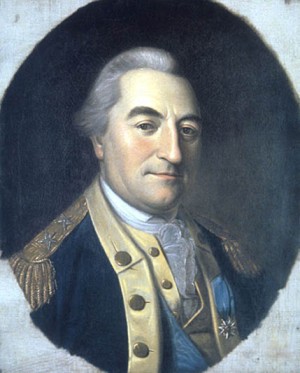|
Notes
1. This Royal French Army regiment was named after its commander: the comte de Lowendal (1700-1755) (Ulrich Frédéric Valdemar) who was born 6 April 1700, at Hamburg, into a Danish family. Lowendal's early military career � rising from a private to colonel � was in service under Auguste de Saxe, king of Poland. In 1743, Maréchal Maurice de Saxe introduced Lowendal into the French Army and suggested his promotion as Lieutenant General. Lowendal obtained letters of "naturality" (became French) and abandoned Lutheranism. He was authorized to create a German-speaking regiment. Commanding his regiment, Lowendal distinguished himself at Fontenoy (1745), took Bergen op Zoom (1747) and was created mar�chal on 17 September 1747. He retired after the peace of Aix la Chapelle and was made a Member of Academie des Sciences in 1754. Lowendal died on 27 May 1755, in Paris.
2. Comte Charles de Broglie -- a well known and high ranking French officer who organized the famous diner in Metz (August 1775) that exposed Lafayette the to views of the visiting Duke of Gloucester, the brother of the English George III. The English duke expressed sympathy with the insurgents' revolt in America. This meeting sparked the young marquis' imagine and awakened a path for possible glory in pursuit of a noble cause. Initially, comte Broglie-Ruffec, nursed the idea to lead the Insurgent' armies in North America and he envisioned DeKalb and Lafayette being 'an advance' team to support such a scheme in America. DeKalb was aware of Broglie's motives, but Lafayette was not. Soon after he arrived with Lafayette in American, DeKalb had to inform Broglie that his plan was not viable. [See "The Broglie 'French Connection' ..."]
3. Interestingly, as with the Polish military volunteers in the American army, Steuben's service was sponsored by the French government and contemporary references to him in the American war are as 'de Steuben'. Steuben was born in the kingdom of Prussia, and reportedly his father inserted the �von' in his name at birth, though his family was not of the nobility. His served on the Prussian General Staff -- which was an advanced military innovation at the time --, achieving the rank of captain befor being discharged in 1763. He sought re-employment in other German-speaking communities such as Austria and Baden. Eventually, he sought to serve in a German-speaking French unit in 1777. He was fortunate to be recognized by the French Minister of War (Count de St. Germain) who appreciated the ex-Prussian officer's unique military staff experience and its value to assist the newly formed American Continental Army. With travel funds advance by the French, and letter of introduction from Franklin -- refering to the Prussian volunteer having been a "Lieutenant General in the King of Prussia's service" � , Steuben reported to General Washington at Valley Forge in February 1778.
Steuben did not yet speak English, but his French was sufficient so as to communicate with the assistance of French English-speaking volunteers and several French-speaking American officers. He is famous for injecting into the Continental Army the essentials of battlefield troop formation maneuvers, competence in the combat use of the bayonet, and camp sanitation -- all of which transformed the American army after the 1778-1779 Winter of Valley Forge.
|

